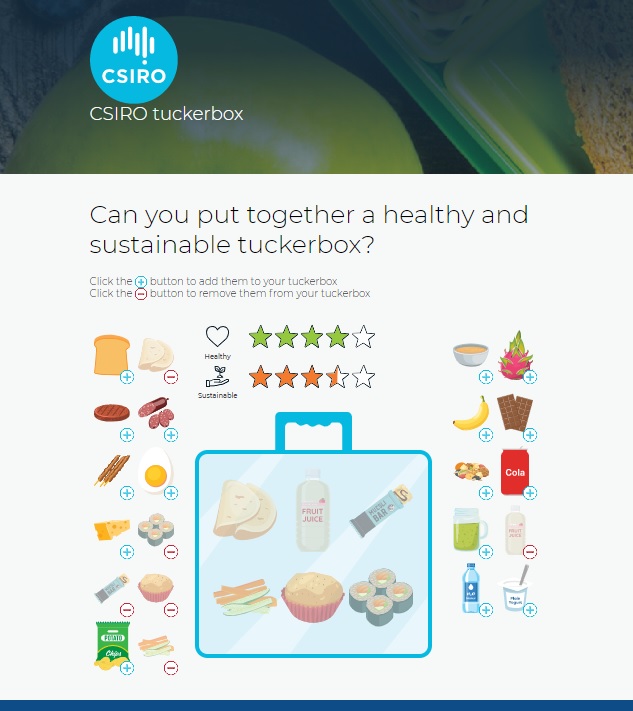It’s not always easy to eat healthily. And making sustainable food choices is certainly not straightforward. When you try to combine the two, it gets even trickier.
Foods that are healthy do not necessarily have higher or lower environmental impacts. And foods that place lower pressure on our environment might not always be the healthier choice. People are increasingly taking an interest in how their food is produced. But how can you choose what’s good for you and good for the planet?
Tuckerbox by design
To help, we’ve developed the CSIRO Tuckerbox for National Science Week 2021 in line with this year’s theme of Food: Different by Design.
The CSIRO Tuckerbox lets you design a healthy and sustainable lunch, based on science. You can choose six items to add to your tuckerbox from a selection of over 20 food and drinks. When you select an item, you see how it rates for both health and sustainability.
Will you choose white bread or a wholemeal wrap? A beef satay or sushi with salmon? Which is healthier? Which is better for the environment?
Most of us know what foods are healthy or unhealthy. But do you know whether a banana or a packet of potato chips takes more greenhouse gases to produce?

The CSIRO Tuckerbox can help you make healthy and sustainable choices.
Climate, water and land
When it comes to making sustainable food choices, there are many things to consider. Not only greenhouse gas emissions but also how much water was used to produce a particular food. And whether additional land was cleared to farm it.
Our scientists recently developed a weighted environmental impact score to assess a wide range of foods we produce and eat in Australia. The score includes the climate footprint, water-scarcity footprint and cropland-scarcity footprint for each food item from the paddock to the plate to give a combined ‘sustainability’ score. We used this to rate items in the CSIRO Tuckerbox.
Some of the ratings might surprise you. For example, lamb meat scores very low for environmental impact, much less than blueberries or coffee.
Making it healthier
Healthy, unhealthy, junk, processed, fast, organic, these are just some of the labels we put on food and drinks. It’s no wonder we get overwhelmed when it comes to selecting what should and shouldn’t go into our lunchboxes.
The advice from our nutritional scientists is that Australians should focus on eating a range of foods from the five food groups set out in the Australian Dietary Guidelines. Including vegetables, fruit, wholegrains, low-fat dairy and lean meat or alternatives, such as tofu and legumes.
However, it’s not all carrot sticks and water. You may be surprised to know that the Australian Dietary Guidelines also allow for a small amount of discretionary foods, also known as ‘sometimes’ foods, as they can add variety and enjoyment to our lunchboxes.
One thing that is not in doubt is that we should be putting more fruit and vegetables into our lunchboxes. With only five per cent of Australian children and one in 20 Australian adults eating enough fruit and vegetables.
See if you can swap out one discretionary food item from your lunchbox to make room for a healthier choice and watch those healthy stars go up.
Packing your future tuckerbox
The CSIRO Tuckerbox suggests a selection of foods you might have for lunch in the future. Fancy an algae snack? Or perhaps a muffin baked by your own robotic chef to your particular health needs, diagnosed by your smart toilet.
While some of these future foods may be a few years away, others are well advanced. Our researchers are working on food that responds to consumer demands and the needs of a growing population, such as new forms of protein, allergen-free nuts and dairy without the cow.
We’re continuing what we’ve been doing for more than 100 years. That is, designing food alongside Australian industries, whether it be crops and livestock adapted to our environment, or helping people make their diets healthier.
We’re also looking at how we can improve sustainability in food production through the use of new technologies that transform how we produce, process, transport food.
So, this science week, go ahead and take the CSIRO Tuckerbox challenge. Perhaps it will make you choose food differently next time and design your meals and snacks to be a little healthier and more sustainable.


20th August 2021 at 7:57 am
What a great resource! Would love to see more food options but keen to use it with the kids I teach!
19th August 2021 at 4:52 pm
Well I tried to do this exercise but clicking didn’t produce results AND the images were too small and in some cases not easily identified–there’s a bowl of orange stuff and some orange strips (are they carrot sticks?) and what’s that green stuff in the jug and … and … Clear images and ease of operation.
19th August 2021 at 10:54 am
Hmm, couldn’t put coffee in my lunchbox – that won’t work! 🙂